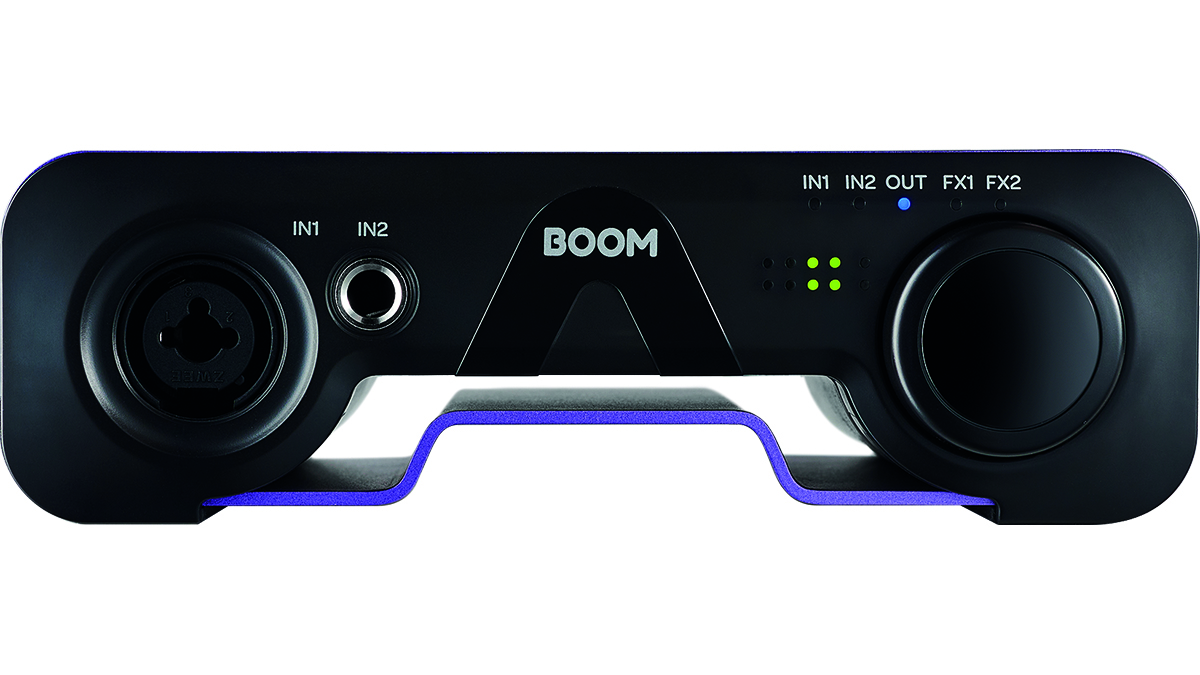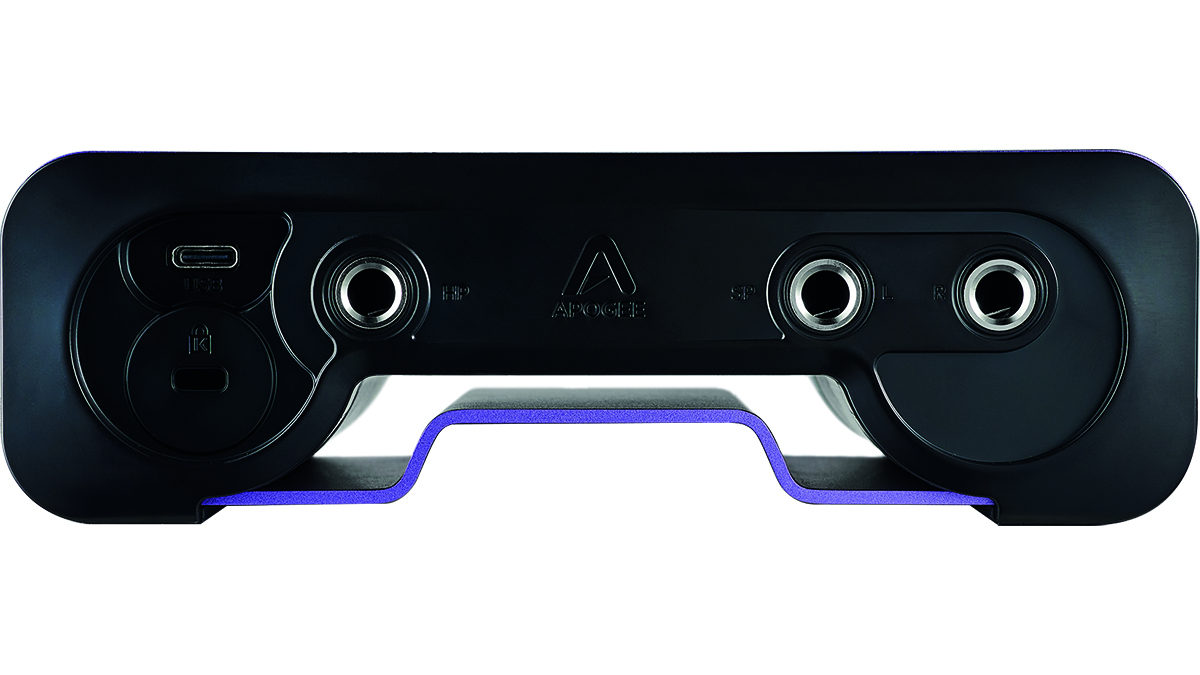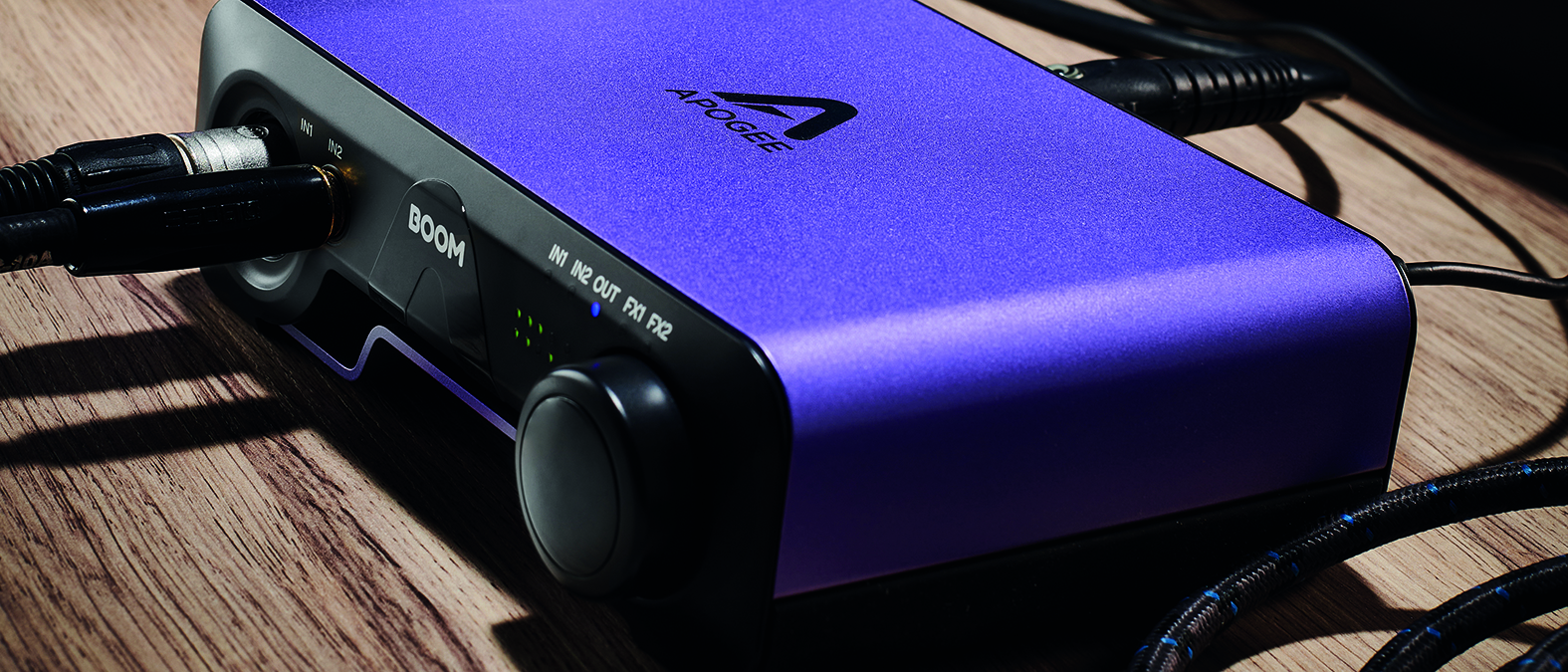MusicRadar Verdict
It has excellent converters and a great preamp but the Boom is let down by its second analogue input and headphone implementation.
Pros
- +
A/D and D/A converters are excellent, a decent preamp and software performs well.
- +
Superb headphone amp.
- +
Onboard DSP effects.
Cons
- -
Limited I/O for the money.
- -
Frustrating headphone/main outs implementation.
- -
Plastic front and rear panels, and cheap rotary encoder.
MusicRadar's got your back
Apogee Boom: What is it?
Ever wished premium brand Apogee would make an accessible entry-level interface? Well, boom! Here it is… The Apogee Boom is a basic box with some fine-quality components. Is it good value? Let’s find out.
The Boom is wrapped in a metallic purple aluminium casing. Flip it over and you’ll discover that its fluted base has generously rubber-coated feet that form the lower part of a capital A when viewed from the front. Unfortunately, the plastic front and back panels aren’t so impressive.

On the front panel from the left, there’s a single combi (mic/line/instr) input, a ¼” instrument input, two rows of five LEDs and a single, large multi-purpose rotary encoder for setting gain, adjusting volume and selecting inputs and outputs. Above this is a further row of five LEDs that illuminate when either of the inputs or the output is selected, or if either channel has onboard effects applied.
Round the back there’s a single USB-C socket, a ¼” headphone jack, two ¼” balanced outputs and a Kensington security slot. The Boom is bus-powered via Mac, Windows or iPad. A USB-C lead, with nifty integrated USB-A adapter, is included in the box and Apogee Control 2 and Ableton Live Lite software is ready for download when you register online.

Apogee Boom: Performance and verdict
Apogee is targeting everyone with the Boom, from pro music producers looking for a portable solution to first-time content creators and podcasters. So why did Apogee give us a ¼” instrument input on channel two instead of a second XLR combi jack? Surely, many users will feel constrained by that choice?
Let’s get the other negatives out the way too. The twin row of LEDs are there to help set gain and output levels but with just five lights on each row it’s impossible to make accurate judgements. The rotary encoder feels cheap, and whose idea was it to put the headphone jack on the back? Worse still, once your headphones are plugged in they mute the main outs. You can’t listen to both, and there’s no hardware or software switch to swap between the two.
Right, now on to the positives. The bundled Control 2 software is a joy to use. Once fired up on MacOS, iPadOS or Windows it enables the easy setting of accurate levels, 48V phantom power and sample rate, from 44.1kHz to 192kHz. Control 2 is also where two additional Playback channels can be configured for streaming content (loopback) from your computer. All four channels can be mixed in Control 2’s mixer pane, and although only one output is active at a time, it’s possible to set different source settings and output levels for the headphone and speaker outputs.
The software also reveals one of the Boom’s most powerful features – internal DSP capability that enables it to run two instances of Apogee’s Symphony ECS Channel Strip plugin. EQ, compression and drive can be added directly to analogue sources or streamed material without any processor overhead on your computer or tablet. The caveat is, of course, that once applied it’s hard-baked in.
The Boom features just one preamp, with a claimed EIN of -123dB A-weighted. In real world tests it sounded quiet enough, but no more so than many other mid-level interfaces. What is impressive is the Boom’s ability to muster up 62dB of gain, enough to handle a gain-hungry dynamic mic such as an SM7B without the need for a Cloudlifter.
The A/D and D/A converters are superb, with dynamic ranges of 122dB A-weighted and 114dB A-weighted respectively. The headphone amp is also a real treat; its frequency response is almost dead flat and its output impedance of 0.5 Ohm will work well with almost any set of cans you plug in, including high impedance audiophile models.
The Boom is a curious beast. It’s equipped with some of the best converters in the business and a decent preamp, capable of generating some serious gain. The onboard DSP effects are another very exciting feature, provided you don’t mind your sound being permanently transformed before it’s fed to your DAW. But the Boom’s been hobbled by mixed build quality, the one combi input and that appalling headphone jack placement. There’s no getting away from the fact that this end of the market is full of excellent 2x2 interfaces that can be yours for considerably less.
MusicRadar verdict: It has excellent converters and a great preamp but the Boom is let down by its second analogue input and headphone implementation.
Apogee Boom: The web says
"In sonic terms, the stand‑out feature of the BOOM for me was its headphone amp. This outperforms those found in most other bus‑powered interface, and to my ears, actually sounds better than the headphone amps in many mains-powered devices."
Sound On Sound
Apogee Boom: Hands-on demos
Apogee Electronics
Julian Krause
Podcastage
Sweetwater
Apogee Boom: Specifications
- KEY FEATURES: 2x2 USB-C audio interface. Up to 24-bit/192kHz recording I/O: 1 x ¼” Instrument input, 1 x Combi mic/line/instrument input, 2 x ¼” Balanced outputs, 1/4” Headphone output. Bus powered, Onboard hardware DSP FX, MacOS, iPadOS and Windows compatible WEIGHT: 0.95kg DIMENSIONS: 250 x 190 x 75mm.
- CONTACT: Apogee
When Simon's childhood classical guitar teacher boasted he 'enjoyed a challenge', the poor man had no idea how much he'd underestimated the scale of the task ahead. Despite Simon's lack of talent, the experience did spark a lifelong passion for music. His classical guitar was discarded for an electric, then a room full of electrics before Simon discovered the joys of keys. Against all odds, Simon somehow managed to blag a career as a fashion journalist, but he's now more suitably employed writing for MusicRadar and Guitar World. When not writing or playing, he can be found terrifying himself on his mountain bike.
“A synthesizer that is both easy to use and fun to play whilst maintaining a decent degree of programming depth and flexibility”: PWM Mantis review
“I feel like that song had everything we needed to come back with”: Bring Me The Horizon’s Lee Malia on Shadow Moses, its riff and the secrets behind its tone, and why it was the right anthem at the right time
“I said, ‘Are we sure we can write a song about death?’”: The story of Mike + The Mechanics' classic No.1 The Living Years











